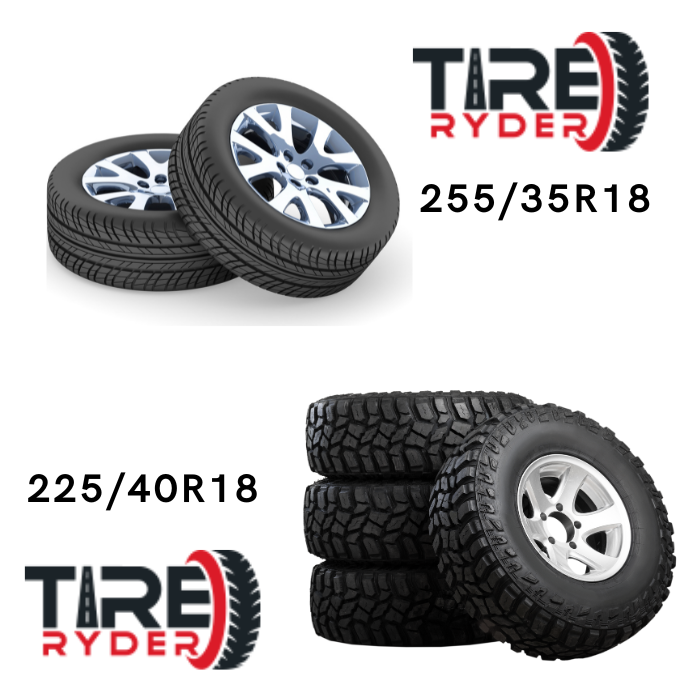Deciding on the right tire size for your car can make a lot of difference in performance, handling, and aesthetics. As you might guess, these two sizes 255/35R18 and 225/40R18 are common on performance cars and sporty sedans. But both of them offer different driving preferences and needs.
In this article, we will compare 255/35R18 vs. 225/40R18 on dimensions, performance, applications, advantages, and much more. After reading this article you will know which tire size might be better for your driving needs.
Breaking Down Tire Dimensions
Each tire size carries specific numbers that can help you choose the right tire for your needs. Let’s decode them for both 255/35R18 and 225/40R18:
Much of the difference in performance and suitability of these tires is due to the difference in aspect ratios.
Performance Characteristics
Traction and Grip
255/35R18:
Due to shorter sidewall, the wider contact patch gives more grip and stability, especially at high speed on dry roads. That is why it is the best choice of sports cars and performance sedans.
225/40R18:
The narrow contact patch means lesser grip but a better performer in wet conditions because it reduces the risk of hydroplaning. It also provides good traction for daily use and light performance.
Handling and Stability
255/35R18:
Features wider tread and lower profile for precise handling, high lateral stability, and good cornering even in aggressive driving.
225/40R18:
The taller sidewall can endure more road imperfections than the shorter sidewall, giving a smoother ride and handling under normal driving conditions.
Comfort and Ride Quality
255/35R18:
The lower sidewall means the ride will be a little firmer. It is designed for performance driving, but it’s not going to be very comfortable on rough roads or long trips.
225/40R18:
The sidewalls are slightly taller, which adds in the shock absorption, resulting in a smoother ride over uneven surfaces.
Fuel Efficiency
255/35R18:
The increased width will increase rolling resistance, slightly decreasing fuel efficiency. This tire size would rather suit a performance size than an economy one.
225/40R18:
Because this is narrower, there is less rolling resistance which results in a more efficient fuel consumption.
For better fuel economy, 225/40R18.
Durability and Longevity
255/35R18:
Its wide design can make faster wear, especially if the tires are driven aggressively. The lower sidewall is also more prone to uneven surfaces.
225/40R18:
Dual sidewall construction generally wears more evenly, and lasts longer, especially for regular commuting or highway driving. But it usually gives less sidewall height and width.
Aesthetic Appeal
255/35R18
The wider stance and lower profile give vehicles a sportier, more aggressive look. These tires complement larger vehicles and high-performance cars.
225/40R18
While still stylish, these tires don’t have the same aggressive appeal as the 255/35R18. They are more subtle and practical in appearance.
Weather Performance
255/35R18:
The wider tread makes it less ideal for snowy or icy conditions, as it struggles to cut through snow efficiently. However, it performs well in dry or mildly wet conditions.
225/40R18:
The narrower width and taller sidewall handle snowy and wet conditions better, making them more suitable for all-season use.
Winter Driving
If winter performance is crucial, both sizes can be enhanced with dedicated winter tires, but the narrower 225/40R18 will naturally perform better in snow and ice.
Environmental Impact
255/35R18
The higher rolling resistance and faster wear rate contribute to a larger environmental footprint.
225/40R18
The improved fuel efficiency and longer tread life make these tires a more environmentally friendly choice.
Applications and Vehicle Compatibility
255/35R18
Commonly found on performance cars and sports sedans like the BMW 3 Series, Audi S4, or Mercedes-Benz C-Class AMG models.
Best suited for drivers who prioritize speed, handling, and aesthetics over comfort and fuel efficiency.
225/40R18
Often used on compact sedans, coupes, and smaller SUVs like the Honda Civic Si, Subaru WRX, or Volkswagen GTI.
Ideal for everyday commuting, occasional spirited driving, and vehicles that balance practicality with performance.
Cost Comparison
255/35R18
The wider width and performance based design of these tires makes them generally more expensive. You can expect to pay more for the initial purchase and when those become replaceable but this cost will be worth it.
225/40R18
Being a more commonly used size, these tires are more affordable. They tend to last longer, which is a further contribution to their cost effectiveness.
Which One Should You Choose?
The choice between 255/35R18 and 225/40R18 depends on your driving style, vehicle type, and priorities:
Choose 255/35R18 if you:
· Drive a high-performance vehicle and prioritize sporty handling.
· Want a wider tire for aggressive aesthetics and cornering stability.
· Are less concerned about ride comfort, fuel efficiency, or tire costs.
Choose 225/40R18 if you:
· Drive a compact car or sporty sedan for everyday use.
· Prioritize comfort, fuel efficiency, and affordability.
· Need better performance in all-season or winter conditions.
Final Thoughts
255/35R18 and 225/40R18 tire sizes have their own strengths and their uses.. If drivers are looking for performance, handling, and visual appeal then the 255/35R18 is ideal, whereas 225/40R18 offers a balance of comfort, versatility, and cost effectiveness. Knowing these differences will enable you to make a decision informed by differences, which has the effect of making your driving experience better and where you will be corresponding to your needs.
